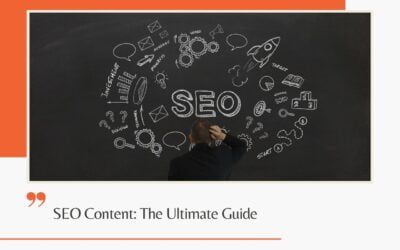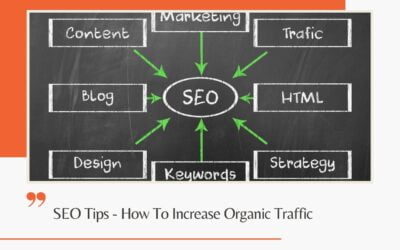Search Engine Optimisation (SEO) refers to the practice of making improvements to increase the quality and number of visitors to a website to improve rankings in the search engine results.
According to research, websites on Google’s first page receive nearly 95% of clicks, and it has also been shown by studies that results appearing higher on the page received more traffic and increased click-through rates (CTR).
The algorithmic (‘free,’ ‘organic,’ or ‘natural’) search results are the ones that are displayed directly under the top pay-per-click ads in Google.
Also, various other listings may appear in Google’s search results, like the knowledge graph, videos, map listings, and more. Search engine optimisation can also improve visibility in the result sets also.
How Does Search Engine Optimisation Work?
Google (as well as Bing which powers the Yahoo search results as well) rate their search results mainly on the authority and relevancy of pages that it crawls and includes in its web index, for a user’s query in order to provide them with the best answer.
More than 200 signals are used by Google to score their search results. Creative and technical activities are encompassed by SEO to improve and influence some of the known signals. It frequently is useful to not focus so much on the individual ranking signals and instead look at Google’s big goal or providing users with the best answers.
Therefore, SEO involves ensuring that a website is technically sound, accessible, used words that individuals type into search engines, and offers an outstanding user experience, with high quality and useful expert content to help answer the query of the user.
Google has a huge team of search quality raters who evaluate the quality of its search results, and this gets fed into Google’s machine learning algorithm. The search quality rater guidelines offered by Google provides lots of examples and details of what Google considers as low or high-quality websites and content, and that their focus on wanting to reward websites that clearly display their expertise, authority, and trust (EAT).
A hyperlink based algorithm (called ‘PageRank’) is used by Google for calculating the authority and popularity of a page, and although Google is much more sophisticated these days, it is a fundamental signal still in ranking. Therefore, SEO can include activity that helps to improve the quality and number of ‘inbound links’ from other websites to a website. Historically this activity has been referred to as ‘link building.’ However, it is really simply marketing a brand that emphasises online, for example, digital PR or content.
Reputable and relevant websites that link to a website is a powerful signal for Google that may be of interest to users and may be trusted to appear within the search results on queries that are relevant.
How To Do Search Engine Optimisation
SEO involves creative and technical techniques that are frequently classified as “Offsite SEO” and “Onsite SEO.” That is very dated terminology but is useful for understanding it better, since it splits that practices that may be performed on the website and off of the website.
The activities require expertise, frequently from numerous individuals since the skills needed to perform that at a very high level, are very different – but need to be learned as well. Hiring a professional SEO agency is the other option, or an SEO consultant to assist in the needed areas.
Onsite SEO
This refers to activities performed on a website in order to improve organic visibility. That main means optimising content and a website in order to improve the experience, relevancy, and accessibility for users. Typical activities include the following:
Keyword Research – Analyse the kinds of words and frequency that prospective customers use to find products or services. Understanding a user’s expectations and intent from their searches.
Technical Auditing – Making sure that the website may be crawled and indexed, is geo-targeted correctly and is free of user experience barriers and errors.
Onsite Optimisation – Improving the structure of a website, content relevancy, on-page alignment, and internal navigation, to help target the relevant search phrases and prioritise key areas.
User Experience – Ensure that content shows trust, authority, and expertise, is fast, easy to use, and provides the best experience possible for users.
The list above touches only a few activities that are involved, as an overview of Onsite SEO.
Offsite SEO
This refers to activities that are performed outside of the website in order to improve organic visibility. That is frequently called ‘link building,’ that aims to increase the number of high-quality links from other websites since they are used by search engines to score votes of trust.
Links from pages and websites with more relevancy, popularity, and trust pass more value to a different website, compared to a poor, unknown website that the search engines do not trust. Therefore, the most important signal is the quality of the link.
Some typical activities include the following:
Content (Marketing) – High-quality, reputable websites only link to outstanding content. Therefore, creating incredible content will help to attract quality links. They may include an infographic that includes compelling data, a visualisation, a story, or a how-to guide.
Digital PR – PR gives reasons for other sites to link to and talk about a website. It may be product placement, quotes, expert interviews, original studies or research, write for external publications, and internal newsflow, and more.
Promotion and Outreach – Involves communicating with important webmasters, influencers, bloggers, and journalists about PR, content, resources or brands to earn coverage and links to your website, ultimately.
There are obviously many reasons why a website may link to another site, and they don’t all fit into the above categories. A good rule to follow on whether a link is going to be valuable is to take into consideration the quality of the referral traffic you might receive (visitors that may click on the link to go to your site). If a website will not be sending any visitors, or their audience is totally irrelevant and unrelated, then it may not be a link that is really worth pursuing.
It is very important to keep in mind that link schemes like low-quality articles and directories aiming to manipulate the rankings of Google, excessively exchanging links, or purchasing links are against Google’s guidelines and could result in the search engine penalising a website.
The most sustainable and best approach to improving a website’s inbound links is to earn them through providing compelling and genuine reasons for sites to cite and link to their content and brand for why they really are and the content they create or the product or service they provide.
Do You Need Assistance With Your SEO?
Our company runs extremely successful SEO campaigns within the most competitive sectors, through the use of a unique blend of creative and technical expertise.
We know that pushy salespeople are the worst, which is why we do not have any. So if you want to discuss how SEO can benefit you, please contact me for a chat.





0 Comments